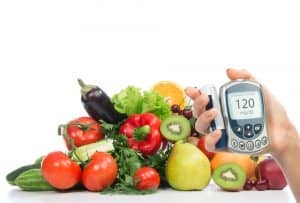Many people know about the advantages juicing may have for just about anyone. Juicing for diabetics needs extra attention though because of the risk of increasing blood sugar levels. You need to be careful to follow the best juicing for diabetics practices.
Juicing lets you drink the foods you usually eat and, at the same time, get massive quantities of nutrients from the vegetables and fruits in a very brief order.
People with Type 1 or Diabetes type 2, do need to be careful with juicing because placing too much sugar in their body at once can cause mayhem on their blood sugar and glucose levels.
Commercial juices include high fructose corn glucose or HFCS; some do not. HFCS is a highly refined sweetener everybody needs to steer clear of.

Here are a few facts about juicing and a few modifications someone with diabetes mellitus may have to create to be able to integrate it into their dietary plan.
At any time you choose a supplement in pill form, it has to go through your whole digestive system to be consumed. Most experts agree a small portion of nutrients is in fact consumed by your system when taken in tablet form.
At any time you choose a substance in liquid form, it is almost immediately processed and consumed by your body.
1. Why Diabetics Need to Be Careful About Their Diet
For this reason, diabetics must be careful about the glucose content in any juices they produce and drink. Make certain to include a variety of fruits and vegetables.
Try to choose fruits low in sugar, so you do not raise your blood sugar level. You might also try adding protein to slow down accurately the assimilation of sugar.
You can do this in the shape of protein powder, or walnuts. Doing this helps slow down the absorption of the sugar in your blood. It is best to use fruits categorized as low-GI when juicing. The glycemic index or GI is reduced.
2. For example, cherries grapefruit and pears are ideal for juicing.
In addition to having a low-GI of 38, they include reasonable amounts of fiber. Fruits to avoid include, watermelon, pineapple, mangoes, and cantaloupe. Here’s something to think about.
Would you take a seat and eat eight apples or a couple of bananas at one sitting? Even when drinking low-GI fruits, you still need to think about the total glucose content.
Based on a study published in the journal Diabetes mellitus Care in 2008, only one serving of fruit juice per day increased the risk of developing Diabetes type 2 in women. Many individuals believe juice fasts may detoxify your system.
This could be extremely dangerous for a person with diabetes to carry out without medical supervision. People with diabetes mellitus need to eat every couple of hours at a sequence to maintain their levels of blood sugar stable.
3. How To Manage Diabetes
Given the acute consequential effects of insulin resistance and type 2 diabetes. Appropriate monitorization of levels of blood sugar is among the key ways in helping to avoid any potentially significant health complications that may arise.
By adhering to a few simple steps such as those listed below, everybody can keep control of their levels of blood sugar, dietary intake, weight, and anxiety levels in establishing the path to a healthy life.
Being overweight is among the primary contributing factors of type 2 diabetes. Losing body weight might help to attain moderate levels of blood sugar, keeping the condition under control.
In case you’ve type 2 diabetes mellitus, you do not need to shed a ton of weight to acquire the benefits. An easy 10 to 15 pounds can lower glucose levels by a profound margin.
Maintaining a healthful diet with moderate consumption of fat and refined carbohydrates might help out with preventing excessive, pointless fat accumulation. An excellent type 2 diabetes mellitus treatment is just paying particular focus on your carbohydrates and fats ingestion.
These increase the levels of blood sugar rapidly due to their fast absorption, resulting in rapid insulin release and overworking the pancreas. Doing so prevents surges characterized by high blood glucose and fluctuations in levels of blood sugar.
4. Juicing to Control Blood Sugar
Foods with a high glycemic indicator, processed sugars, and starches may include energy beverages, white bread, and white rice. Stay away from fast foods with high degrees of unhealthy fats to avoid unnecessary fat gain.
Apart from playing an essential role in preventing cardiovascular conditions, regular workouts are crucial in controlling and preventing type 2 diabetes. Regular exercises improve the sensitivity of insulin by optimizing muscle function, helping to stabilize levels of blood sugar.
Routine workouts contribute to reducing levels of blood sugar and cover a few more bases by improving body weight and maintaining blood pressure level control. The higher the intensity of your workout program, the better the outcomes with regards to combating type 2 diabetes.
High stress is also altering sleep patterns, preventing you from getting better and sufficient sleep every single night. Research has shown that lack of sleep worsens type 2 diabetes.
Are you stressing too much? Trying Tai chi, yoga, meditation, getting a massage, and even just listening to music might help relieve stress and help you get into better sleep patterns.
Avoiding caffeinated drinks, spicy foods, and alcohol before bed may also contribute to improving the quality of your sleep. Blocking out all noise and sounds to prevent interruptions during the night is a big help. Maintaining a regular sleeping pattern might help your body achieve consistent quality sleep.
5. Diabetes and Food Choices
Called medical nutrition therapy, a diabetes mellitus diet involves eating a wide selection of foods high in nutrient value in moderation, even while adhering to regular meal times.
Eat three meals each day: Eating breakfast, dinner, and lunch will help to control levels of blood sugar. Studies have also shown that eating three proper meals avoid snacking and help in weight control.
Include carbohydrates in diet: Include healthy fats foods such as cereals, pasta, bread, potatoes, yam, chapatis, and rice to help control blood sugar levels. The National Diabetes mellitus Information Clearinghouse recommends a minimum of one serving of starch at every meal.
6. Healthy Diabetes Diet Tips
Some very healthy selections are the high fiber variety which has whole grain variations of bread, porridge oats, yam, sweet potato, fresh potatoes, crackers, natural all Bran muesli cereals, and tortillas.
These foods will also help the digestion and prevent constipation problems from arising. Using the right produce helps the digestion when juicing for diabetics, so choose foodstuffs wisely.
Eat foods full of Fibre: A diet that contains five servings of veggies and fruits is advocated to be able to supplement the body with the essential vitamins, minerals, and fiber.
Other foods such as beans, lentils, peas, wheat bran, and nuts can also control blood sugar. Not only can a diet high in fiber help to control levels of blood sugar, but it might also reduce the possible risk of coronary illness.

Eat at least two servings of oily fish per week: Oily fish such as salmon, mackerel, sardines are rich in omega 3, which can help to protect your heart by reducing triglycerides.
Reduce glucose intake: Opting for glucose-free choices can lessen your sugar consumption significantly.
Cut your salt intake: You should aim for less than 2, 300 mg of salt a day. High blood pressure levels might lead to heart problems and stroke.
Processed prepared meals usually contain high degrees of salt and are best avoided. Diabetic meals have to be planned so you can get the most benefits, nutrients, and enjoyment from them.
7. Type 2 Diabetes Complications You Can Avoid
These diabetes mellitus complications are related to blood vessel disease and are often classified as little vessel diseases, such as those between the eyes, nerves, and kidneys, and large vessel disease between the heart and blood vessels.
Diabetes mellitus accelerates the hardening of the arteries of these larger blood vessels, resulting in cardiovascular disease, strokes, and pain in the lower extremities due to insufficient supply of blood.
The primary eye complication of diabetes mellitus is called diabetic retinopathy. Diabetic retinopathy occurs in patients who’ve had diabetes mellitus for at least five years. Diseased little blood vessels in the back of the eye cause this utilization of blood and protein from the retina.
Disease in these blood vessels also leads to the creation of small aneurysms, and new, but brittle blood vessels. Spontaneous bleeding from the fragile and new blood vessels may cause a retinal scar and retinal detachment, thus impairing vision.
To deal with diabetic retinopathy, a laser can be used to destroy and prevent the recurrence of the growth of these small aneurysms and fragile blood vessels.
Approximately 50% of individuals with diabetes mellitus will develop some degree of diabetic retinopathy following ten years of diabetes mellitus, and 80% of people with diabetes have retinopathy following fifteen years of the illness.
Poor control of blood glucose and blood pressure levels further aggravates eye disease in diabetes. You need to be extra careful when juicing for diabetics to prevent this from happening.
Cataracts and glaucoma are also more prevalent among diabetics. Additionally, it is important to remember that because the lens of the eye allows water through, if blood sugar levels change a lot, the lens of the eye will shrink and swell with fluid consequently. Patients are often discouraged from getting a brand new eyeglass prescription until you have controlled your blood glucose levels.
Kidney harm from diabetes mellitus is called diabetic nephropathy. Initially, diseased tiny blood vessels in the kidneys cause the utilization of protein in the urine.
Later on, the kidneys lose their capability to cleanse and filter blood. This causes an accumulation of toxic waste products in the blood leading to the need for dialysis.
Dialysis involves utilizing a machine that serves the purpose of the kidney by filtering and wiping the blood. The development of nephropathy in patients may be substantially slowed by controlling high blood pressure level, and by aggressively treating elevated levels of blood sugar.
Angiotensin-converting enzyme inhibitors or angiotensin receptor blockers utilized in treating high blood pressure levels can also benefit renal failure in patients with diabetes. Nerve harm from diabetes mellitus is called diabetic neuropathy and is somewhat brought on by diseased small blood vessels.
8. Conclusion: Juicing for Diabetics
If you are juicing for diabetics you need to be aware of the risk of increasing blood sugar levels. By carefully choosing the correct vegetables and fruits you can still enjoy healthy fruit juices and keep yourself in good physical health. There are many good juicing recipes for diabetics so you will have a varied and healthy diet.
- Foods with a high glycemic indicator, processed sugars, and starches may include energy beverages, white bread, and white rice.
- Try to choose fruits low in sugar, so you do not raise your blood sugar level.
- A diet high in fiber helps to control levels of blood sugar, and it might also reduce the possible risk of coronary illness.
- Diabetes mellitus accelerates the hardening of the arteries of these larger blood vessels, resulting in cardiovascular disease, strokes, and pain in the lower extremities due to insufficient supply of blood.
- Angiotensin receptor blockers utilized in treating high blood pressure levels can also benefit renal failure in patients with diabetes.








